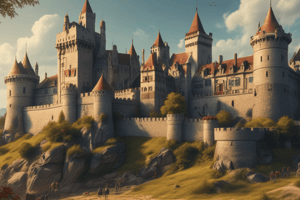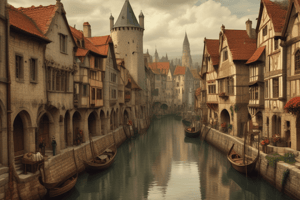Podcast
Questions and Answers
El término 'Medieval' se refiere a un período de transición y cambio en Europa.
El término 'Medieval' se refiere a un período de transición y cambio en Europa.
True (A)
La Edad Media abarcó desde aproximadamente el año 1500 CE hasta el año 2000 CE.
La Edad Media abarcó desde aproximadamente el año 1500 CE hasta el año 2000 CE.
False (B)
Feudalismo era un sistema social basado en relaciones de tenencia de tierras que unían a nobles, caballeros dependientes y campesinos.
Feudalismo era un sistema social basado en relaciones de tenencia de tierras que unían a nobles, caballeros dependientes y campesinos.
True (A)
El Imperio Romano de Occidente continuó existiendo hasta el año 1453 CE bajo los Bizantinos.
El Imperio Romano de Occidente continuó existiendo hasta el año 1453 CE bajo los Bizantinos.
Las migraciones germánicas durante el período de las Invasiones Bárbaras ocurrieron aproximadamente entre los años 200-375.
Las migraciones germánicas durante el período de las Invasiones Bárbaras ocurrieron aproximadamente entre los años 200-375.
La cultura cristiana se entrelazó profundamente con la vida secular durante la Edad Media.
La cultura cristiana se entrelazó profundamente con la vida secular durante la Edad Media.
Las Cruzadas tenían como objetivo principal expandir el control musulmán sobre Jerusalén y Tierra Santa.
Las Cruzadas tenían como objetivo principal expandir el control musulmán sobre Jerusalén y Tierra Santa.
La Peste Negra afectó a Europa durante los años 541-750.
La Peste Negra afectó a Europa durante los años 541-750.
Leonardo da Vinci fue una figura influyente durante el período medieval.
Leonardo da Vinci fue una figura influyente durante el período medieval.
Las figuras históricas medievales, como Dante Alighieri y Cristóbal Colón, reflejan la complejidad y riqueza de la época.
Las figuras históricas medievales, como Dante Alighieri y Cristóbal Colón, reflejan la complejidad y riqueza de la época.
Study Notes
Exploring Medieval Europe: A Time of Transition and Change
The term Medieval, often used interchangeably with Middle Ages or simply Mid-Age Period, refers to a significant era spanning from around the year 500 CE to approximately 1500 CE. This expansive timeframe encompasses diverse changes, developments, and challenges that shaped Europe—and indeed, much of the world—into what it is today. As you delve into this fascinating period, let's highlight some essential aspects and events of medieval European history.
Origins of the Medieval Era
While there isn't one definitive starting point for the Middle Age period, scholars generally agree on its beginnings due to several notable occurrences. In Western Europe, the fall of Rome, marked by Odoacer's deposition of Romulus Augustus in 476 CE, signaled a shift away from classical antiquity. Meanwhile, the Eastern Roman Empire continued until 1453 CE under the Byzantines. Additionally, the Germanic migrations, which brought new languages, customs, religions, and peoples across Europe during the Migration Period (approximately 375–550), played a pivotal role in setting up the foundation for future centuries.
Key Events and Trends
Feudalism: One defining feature of the Medieval period was feudalism, a social system based upon land-tenure relationships binding together nobles who possessed fiefs, their dependent knights, and peasants working the land. Feudal contracts were intricate networks providing protection and support—a central theme throughout the age.
Rise of Christianity: During the Late Antiquity period leading up to the Middle Ages, Christianity spread rapidly across Europe through missionary activity and political influence. Eventually, Christian culture became deeply entwined within secular life, giving birth to powerful church institutions like monasteries, cathedrals, abbeys, and religious orders such as the Benedictines and Cistercians.
Trade and Commerce: Medieval Europe saw a renaissance in trade and commerce, driven largely by urbanization and the growth of cities. Major trading centers emerged along key routes, connecting cultures, markets, and ideas across vast distances.
Crusades: Beginning in the late eleventh century, the Crusades involved military campaigns aimed at recapturing Jerusalem and the Holy Land from Muslim control. While primarily motivated by religion, they also served broader purposes: to secure territorial gains, establish commercial ties, and expand Christendom's borders.
Plague Pandemics: Two devastating plagues struck Europe during the Middle Ages: the Justinian Plague (541-750) and Black Death (1348-50). These epidemics caused widespread death and profoundly altered European society, accelerating demographic shifts, transforming labor patterns, and disrupting economic systems.
Influential Figures: Many iconic historical figures emerged during the Medieval period, including Charlemagne, William the Conqueror, Joan of Arc, Petrarch, Chaucer, Dante Alighieri, Leonardo da Vinci, Christopher Columbus, and more. Their stories reflect the complexity and richness of the times.
These are just a few highlights among countless inspiring narratives from the Medieval period. Although it may seem distant now, understanding these foundations can illuminate how contemporary cultures evolved over centuries, shaping our modern societies.
Studying That Suits You
Use AI to generate personalized quizzes and flashcards to suit your learning preferences.
Description
Delve into the significant era of Medieval Europe (500-1500 CE) marked by diverse changes, developments, and challenges that shaped the continent. Explore essential aspects including Feudalism, Rise of Christianity, Trade and Commerce, Crusades, Plague Pandemics, and Influential Figures.




